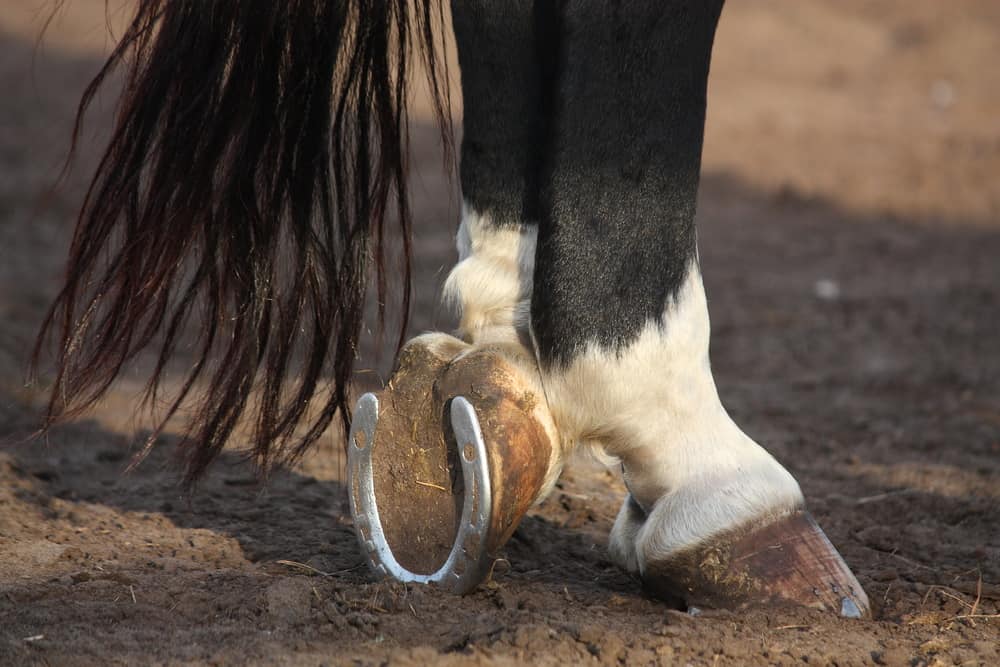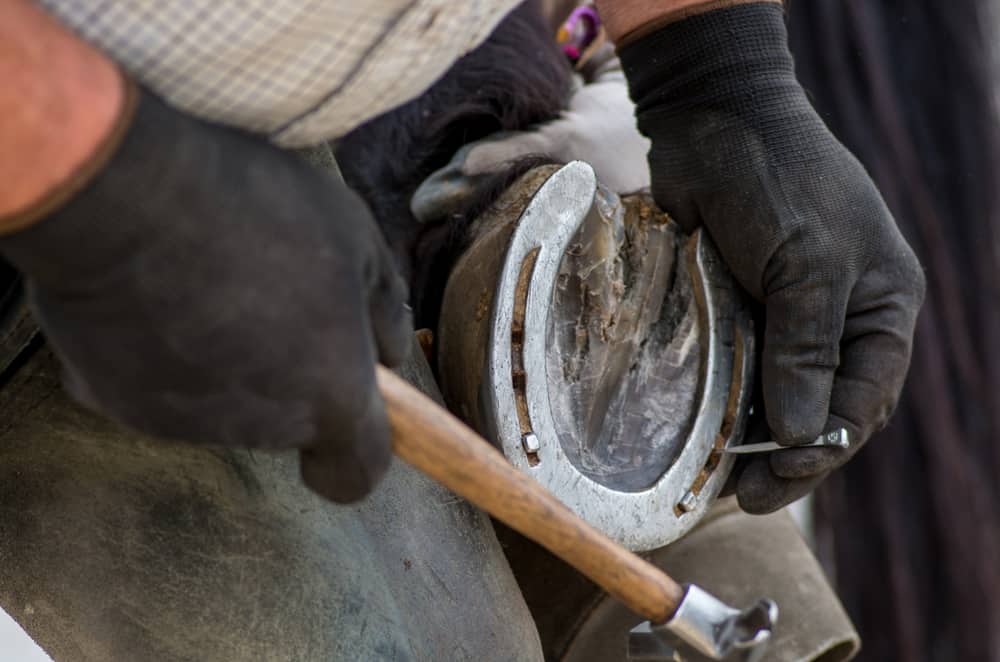I Can t Continue to Wear This Horse

If your horse wears shoes, it's a sure thing he will lose a shoe once in a while. Horseshoes will usually stay on your horse's hooves until your farrier returns, but sometimes horses throw shoes out in the paddock or while you are out on a ride.
You should not ride a horse with a missing shoe. When horses wear shoes, their hooves get used to it. If a shoe comes off, the bare hoof might be extra-sensitive, reduce the height of one hoof and leave your horse unbalanced, the hoof missing a shoe will commonly break up a little, increase the gaps and make it harder for a farrier to reattach the shoe.
If your horse has lost a shoe, it's essential to act quickly if you want to keep your horse's hoof in good shape until your farrier can return to replace or reattach the shoe. Here are a few things you can do.
How to help your horse when he lost a shoe
- Immediately stop riding your horse as soon as you notice he lost his shoe. Riding a horse with a shoe with loose nails can cause pain and damage to your horse's hoof.
- Evaluate your horse's hoof. Look at your horse's hoof to see if the horseshoe is loosely attached and if any nails have been driven into your horse's sole. Look for any missing pieces of the hoof wall, see if your horse has been seriously hurt or not. Also, see if there are any cracks in your horse's hoof. These cracks can serve as an entry point for bacteria, which can lead to an abscess.
- Remove any nails. The remaining nails that are still in your horse's hoof should be removed. Slowly and gently walk your horse to your stable. If the horseshoe is still attached to your horse's hoof, but it's missing several nails and only loosely attached, use crease nail pullers to grab any protruding nail heads and pull them out of your horse's hoof. If you don't have crease nail pullers, use a strong pair of pliers to remove the protruding nails. Make sure you pick up all the nails you pulled out to prevent your horse from accidentally stepping on them.
- Cover the hoof. If your horse seems to be footsore, you should cover the bottom of your horse's hoof with padding. Use a hoof boot to protect your horse's hoof. Loosen the straps on the hoof boot and place your horse's hoof into it. Make sure to center the boot on the hoof. Then, pull the heel captivator up and tighten the straps to secure the boot to the hoof. It's a good idea to have somebody hold the horse for you while you do this. If you don't have any hoof boots available, try using a size five diaper. It's effortless to use.
Every horse owner's first aid kit should have some medium-sized diapers. The diapers are great for poulticing sore feet and cover wounds. Grab a diaper and put it around the hoof, so most of the padding covers the sole. Then cover it with vet wrap and secure the diaper as you would for a poultice. Then attach the vet wrap and padding with some duct tape. It is essential if the farrier can't get there quickly, as you need to protect your horse's hoof in the meantime.
- If any bleeding occurs. When your horse has lost a shoe, sometimes a piece of the hoof can come off as well at the same time. If your horse has any bleeding coming from his hoof, administer first aid to the wound immediately and call your vet. Your horse probably needs antibiotics; any infection in a hoof is very dangerous and extremely painful. Remember to look for the lost horseshoe, as it might have sharp nails sticking out. If it is left in the pasture, you or your horse may step on it.
- Call your farrier immediately. Your horse will need to be evaluated by your farrier to be fitted with a new shoe as soon as possible. Do not try to reattach a new shoe yourself unless you are an experienced farrier yourself. The only person legally permitted to shoe your horse is a registered farrier who has undergone four and half years of training.
How to avoid your horse losing a shoe
Avoid riding in areas where your horse can quickly lose a shoe. When your horse is walking around in deep mud or on parched ground, your horse will most likely lose one of his shoes. Some horses also end up losing a shoe when sticking their feet through fences and pulling their shoes off that way when it gets stuck.
Pick and inspect your horse's hooves before and after each ride. Pick up your horse's foot so that you can see the bottom. You should use a hoof pick to clean out any dirt and other debris caught in your horse's hoof. If you don't ride your horse every day, you should at least pick your horse's hooves once daily to inspect and maintain proper hoof health.

How often should you shoe your horse?
Horses need horseshoes when they wear their hoofs faster than they grow. Horses that become footsore may show mild lameness, poor performance, and rebellious behavior. The kind of work a horse does is a significant consideration too. A ridden horse will wear his hooves more quickly than the horse simply grazing in a pasture.
Your horse should be shod every 4 to 6 weeks at least. You may need to have your horse shod on a more frequent basis if you ride your horse more than 10 miles a day.
Discuss your horse's routine with your farrier to find out what sort of schedule you should adapt to replace the shoes on your horse's hooves.
Your horse should never go more than eight weeks without having his shoes replaced. How fast your horse's hooves grow and the kind of work your horse does will also dictate how often your horse needs to be shod.
When your horse has brittle hooves that crack and constantly lose shoes
Talk to your veterinarian about your horse's diet if he has brittle hooves that are dry and crack all the time. Your horse's genetics mainly determines the nature of your horse's hooves. By adding supplements to your horse's diet, it may give your horse stronger hooves that are less likely to throw a shoe. It is essential if your horse's diet consists primarily of starchy carbohydrates or grass.
Horses with a naturally thin hoof wall that constantly cracks and chips will have a more challenging time holding on to their shoes. A horse with even the most tightly set shoe can easily be pulled off when the horse's hind foot overreaches, hits a front heel, and catches the shoe. Approximately eighty percent of lost horseshoes occur on the front hooves. If your horse regularly loses shoes, have him evaluated by your veterinarian.
How much does it cost to shoe a horse?
It generally costs anywhere from $65 – $150 per horse to shoe a horse. A full-time U.S. farrier will charge $131.00 for trim and nailing on four horseshoes. Part-time farriers can charge you an average of $95.00 for the same work.
The cost of resetting your horse's shoes can average $125.50 for full-time farriers, and 95% of farriers reset some keg shoes.
For trimming only, a full-time farrier will charge $45.00. Part-time farriers charge an average of $38.00 for a trim.
What hoof supplements can I give a horse with brittle hooves?
The hoof quality of your horse is affected mainly by his diet. Hoof problems like slow growth and increased occurrences like hoof cracks and lost shoes can often be attributed to nutritional deficiencies. Provide your horse with daily dietary support with a specially formulated hoof supplement to maintain and support healthy hooves.
Here are a few hoof supplements that are available on the market.
- Farnam's Horseshoer's Secret. Buy on Amazon.com
- Farrier's Formula. Buy on Amazon.com
- Focus HF. Buy on Amazon.com
- Vita-Key's ZM-80.
- Select's Nu-Hoof Maximizer.
- Audevard Hoof Biotine.
These links contain affiliate links and we earn a small commission from successful sales.
Conclusion
Riding an unbalanced horse that has lost a shoe can end up causing your horse pain and more severe issues like bruising or an abscess. Horses that are constantly wearing horseshoes get used to the shoes, and their hooves are sensitive when the shoe is off.
Sometimes when a shoe comes off, it breaks part of the hoof wall, and cracks might appear that will make it harder for the farrier to reattach a shoe if more pressure is put on it if you ride your horse without a shoe.
It is recommended to avoid riding your horse when he lost a shoe. Follow the steps explained above to help your horse deal with a lost shoe until a farrier can come and evaluate your horse.
What Horse Has the Best Mane?
Most horses can grow long manes given time. However, certain horse breeds are famous for their long thick manes. Have you ever wondered what kind of horse breeds has the best mane? This article looks...
Do Horses Need Stables?
Horses naturally live outside in nature; provided horses have shelter from the elements and food, they can live outside. So, why do horses need stables? In this article, we discuss if horses need...
Source: https://equestrianspace.com/can-you-ride-a-horse-that-is-missing-a-shoe/
0 Response to "I Can t Continue to Wear This Horse"
Post a Comment